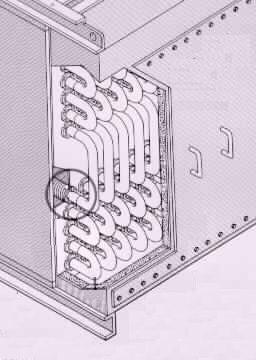 An example of a gas Seal Assembly
An example of a gas Seal AssemblyThe standard method of tube support inside of an economizer is by means of a lattice type design. This is basically like a square rose bush lattice where the tubes go through the boxes. For clean fuel firing boilers this method of support is more than adequate. These designs are an industry standard. Flue gas can enter the endboxes and go around the return bends, but if there is no particulate in the flue gas stream or any sulphur to condense out then the bends and endboxes will be fine.
Before we go any furthur, the weakest link of any economizer must be discussed, the bare return bend area. This area is the part of the unit most susceptible to tube failure for the simple fact it is the coldest part of the tube. The fins transfer heat into the tube wall to keep the finned straight length relatively hot. The bare return bends are also located in the end boxes, where because of low flue gas velocities, a lot of particulates tend to settle out. This combination of particulate fallout combined with low tube wall temperatures could prove a deadly mix for any economizer in a sulphur bearing flue gas.
 An example of a gas Seal Assembly
An example of a gas Seal AssemblyThe lattice design economizer provides little defence for the above applications. To avoid against premature economizer corrosion a heavy duty design needs to be utilized. The key to this type of economizer is the use of solid tubesheets and individual gas seal assemblies. A solid steel tubsheet is manufactured in leu of a lattice design. After the economizer elements have been inserted the gas seal assemblies are welded into the unit. The return bends and endboxes are now effectively isolated from the dirty flue gas. The gas seal assemblies should be designed to properly carry the tube element weight and allow for expansion with no additional wear on the tube itself.
 An example of a Solid Tube Sheet
An example of a Solid Tube Sheet Return to Economizer Information Main Page
Return to Economizer Information Main Page